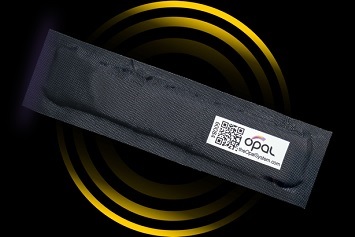Wearables are a hot topic in workplace safety, but there is some skepticism among EHS professionals. To get a first-hand look at a solution that is making waves in the market today, the EHS Daily Advisor talked with Timothy A. Risser, co-founder of the Opal System brand of wearables.
The Opal System is the first go-to-market product from International Thermodyne, Inc. (ITD). The system begins with a patent-pending, thin, flexible, washable, energy harvesting sensor that is attached to personal protective equipment (PPE) such as safety vests or hardhats and connects them to the cloud. By doing so, the Opal System can be used to ensure, record, and measure an individual’s adherence to wearing appropriate personal protective equipment when required whether in the construction, manufacturing, distribution, or other industries.
“At Opal, we have developed a solution that is incredibly easy for the user and the company to implement,” says Risser. “Our primary product is a sensor that harvests energy directly from the wearer’s body to help power the device. This means the user never has to take it off to re-charge. It essentially becomes invisible to the user.”
Since the wearable is incorporated directly into safety equipment, it allows companies to easily understand compliance. “Not only compliance,” notes Risser, “but we can identify where on a site or facility a user is located. This allows for instant understanding if people are safe in times of accidents or incidents and also if people are nearing restricted zones.”
More Efficient EHS Management, Communication, and Metrics
Risser notes that proper use of wearables on a jobsite can help EHS managers streamline their duties, from compliance to emergency notifications. “Our devices can be incorporated into almost any piece of PPE,” he says. “This allows for daily reporting of compliance. We can notify users directly if they are entering a zone that requires specific PPE and they aren’t currently equipped. Additionally, if an accident occurs, we can identify all nearby team members. This allows for safety incident follow up to be more accurately and efficiently managed.”
Wearables can also serve a purpose in cases of site-wide issues such as fire or other natural disasters. “We can immediately identify all team members and their last known locations,” explains Risser. “This way, there is no confusion about head counts or accountability.”
When asked how wearables can help EHS professionals measure the effectiveness of their safety programs, Risser had three words: “Compliance, usage, zone adherence.” This is reflected in some of the most common metrics and uses for wearables such as the Opal System, including:
- A real-time understanding of the number of people entering or leaving a specific work zone;
- The percentage of time over the course of a day that an employee is wearing a specific piece of PPE;
- The number of different PPE devices used by each person;
- The last time a zone was entered or the first entry into a zone; and
- The total time a worker spends in a given zone or wearing PPE.
Concerns Surrounding Wearables
Wearables on the consumer market have sparked privacy debates, and workplace wearables are no exception. Risser says that in his experience, however, this wearable system has not been a cause for concern among most employees. “About 75% of team members are fine wearing wearables,” he says. “The remaining 25% are concerned about being ‘tracked.’”
But even if the concerns are minimal in the workforce, Risser still says it’s vital for employers to acknowledge them. “It is important to address these issues directly and let team members know that there are definitely operational metrics that can be measured, but the primary purpose is to ensure safety,” he advises.
Tomorrow’s Wearables Will Boost Safety
What does the future hold for wearables and workplace safety? “We think that validating proper PPE equipment is in place before certain jobs are performed is going to be key to improving workplace safety,” says Risser, noting that the use of wearables is key to this validation. “That begins with understanding [wearable] usage and getting all the players used to the idea of a smart and connected workforce.”


